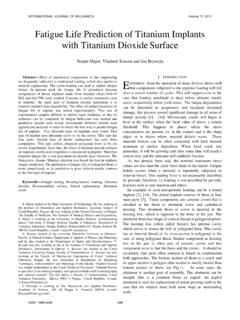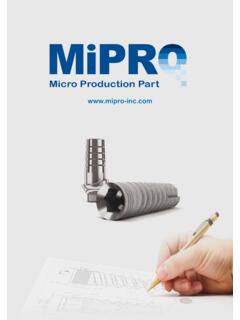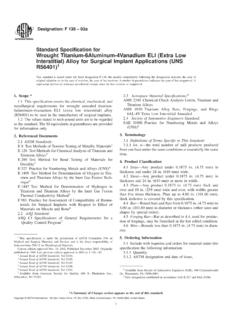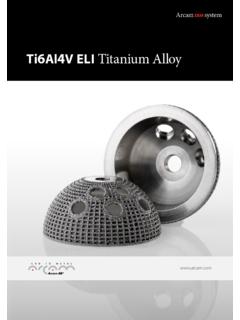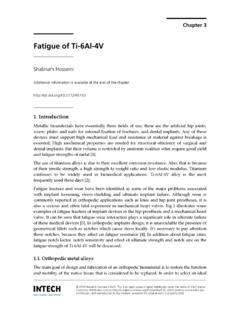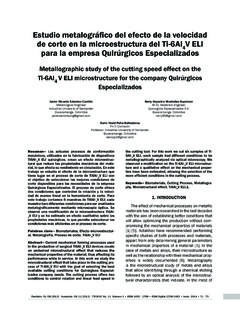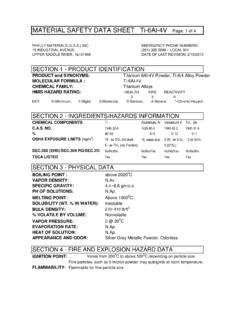Transcription of Effects of Heat Treatment on Mechanical Properties of VAR ...
1 Proceedings of the World Congress on Mechanical , Chemical, and Material Engineering (MCM 2015) Barcelona, Spain July 20 - 21, 2015 Paper No. 344 344-1 Effects of heat Treatment on Mechanical Properties of VAR-Cast Ti-6Al-4V Alloy Seong-Tak Oh, Kee-Do Woo, Tack Lee, Hae-Cheol Lee Chonbuk National University, Division of Advanced Materials Engineering 567 Baekje-daero, deokjin-gu, Jeonju-si, Jeollabuk-do 561-756, Korea Whang-Jin Kang NIB Materials Co., Ltd 750-1, Palbokdong 2-ga, deokjin-gu, Jeonju-si, Jeollabuk-do 561-844, Korea Abstract -Production of casting titanium alloys has been increased due to a significantly high competitive price rather than processed products ( forging, extrusion and rolling).
2 Therefore, advanced casting skills have been developed to manufacture titanium alloys with high quality. However, as-cast titanium alloys have a limit to improve their Properties because of lower Mechanical Properties than forged alloys . In this study, Ti-6Al-4V alloy was fabricated by vacuum arc re-melting (VAR); it is a commercial casting s method. heat Treatment is useful method for improving Mechanical Properties of the casting parts through microstructure s evolution. The main aim of this work is to study relationship between heat Treatment , microstructure and Mechanical Properties have been investigated. Solution Treatment was performed at 950 C for followed by water quenching.
3 After that, the samples were aged at 450, 550 and 650 C. Hardness and tensile tests (at RT and high temperature) were conducted. Scanning electron microscopy (SEM) and transmission electron microscopy (TEM) were used to observe the microstructure as well. The hardness slightly increased with increasing aging time. In addition, tensile Properties at high temperature (400 C) by aging Treatment were improved. Keywords: Cast Ti-6Al-4V alloy, VAR, solution Treatment , aging Treatment , Mechanical Properties 1. Introduction titanium alloy has been widely used in various applications including aerospace, chemical plant and biomaterial industries due to their unique Properties , high specific strength, low density, good corrosion resistant and excellent high temperature Properties .
4 [1-4], In a variety of applications, titanium alloys , which were forged, extruded or rolled, have been used for a lot of parts. However, due to high costs of titanium , technologies of net-shape should be developed actively in the last years. Manufacturing method of titanium was also studied.[2-3] Thus, The VAR process has been extensively utilized as the excellent skill to fabricate titanium ingots having complex shapes, as well leads to cost saving. An advantage of the VAR process is the remelting on vacuum atmosphere. This process can fabricate the ingot having lower oxygen than other methods. This leads to optimum solidification and relatively better Mechanical Properties .
5 [5] Nevertheless, the VAR-cast titanium alloys need post-treatments like the hot isostatic pressing (HIP) and heat Treatment to reduce some casting defects. For these reasons, in order to apply to the Ti-6Al-4V alloy fabricated by VAR process on industries, it needs to improve their Mechanical Properties at room temperature and elevated temperature by aging Treatment or thermo- Mechanical Treatment . [6-9] Therefore, the objective of this study is to analyse the Effects of solution Treatment and/or aging Treatment on Mechanical Properties and microstructure of VAR-cast Ti-6Al-4V alloy. 344-2 2. Experimental Procedure The Ti-6Al-4V alloy was fabricated by the VAR method, and its chemical composition was shown in Table 1.
6 Table. 1. Chemical compositions of Ti-6Al-4V alloy ( ) Al V O H N C Fe Ti Ti-6Al-4V Bal. heat Treatment was carried out in order to investigate the Mechanical Properties and the microstructure. Solution Treatment was performed at 950 C for followed by water quenching, as well as aging Treatment was done. Fig. 1 shows a schematic illustration of heat Treatment . Fig. 1. Schematic illustration of heat - Treatment conditions of Ti-6Al-4V alloy. The specimens were aged at each 450, 550 and 650 C ( and region) for 1 to 24h followed by air cooling. Specimens were etched using a Kroll solution (1%HF, 3%HNO3 and 97%Distilled H2O) for 7 sec, and their microstructures were observed using an optical microscopy (OM), SEM and TEM.
7 The size of lamella microstrucutre were measured using an image analyzer. X-ray diffraction (XRD) was used to analyze the phases. The average hardness of the specimens was measured using a Rockwell F hardness tester under a 60 kgf load for 40 sec. A surface layer was removed by polishing to eliminate any oxidized layer prior to the hardness measurement. Tensile specimens according to ASTM E8 were carried out at room temperature at a crosshead speed of 1 mm/min. In the case of high temperature tensile tests, the tested temperature of samples was 400 C. The temperature was raised up to 400 C and then holded for 15 min and the load was applied. 3. Results and Discussion Microstructure of as-cast Ti-6Al-4V alloy is shown in Fig.
8 2. The microstructure shows Widmanst tten type, consisting of and phases with colony size (parallel-oriented -phase lamellar of 100 - 350 m and lath width of approximately 1-4 m). In the Widmanst tten microstructure, phase is formed along prior grain boundaries. The microstructure after solution Treatment is shown in Fig. 3. Microstructure of as-quenched from 950 C consists of acicular martensite transformed from phase with and retained phases. If the aging Treatment is conducted after water quenching, the martensite transformed to + phases by aging Treatment . 344-3 Fig. 2. Microstructures of the as-cast Ti-6Al-4V alloy: (a) optical micrograph, (b) SEM micrograph. Fig.
9 3. Micrographs of solution Treatment at 950 C for followed by water quenching: (a) optical micrograph and (b) SEM micrograph. Fig. 4. Micrographs of aging treatments at (a) 450 C, (b) 550 C, (c) 650 C for 24 hr followed by air cooling. The microstructures of aged specimen can be seen in Fig. 4. The microstructures have still Widmanst tten type and consist of beta-phase with precipitations of alpha, which lead to the strengthening of specimen. Fig. 5 shows the X-ray diffraction patterns of each heat Treatment . In the as-quenched specimen, both and phase cannot be distinguished because has near hcp structure. Therefore, the peak of and 344-4 phase is overlapped. By aging Treatment , and peak are observed.
10 In aging Treatment at 450 C for 24h, this aging condition is not enough to precipitate 2 phase, while 2 phase is distributed more in matrix by aged at 650 C for 24h. Fig. 5. XRD patterns of (a) solution Treatment , (b) aging at 450 C for 24h, (c) aging at 550 C for 24h and (d) 650 C for 24h. Hardness with each different aging time and temperature is shown in Fig. 6. Hardness slightly increased with increasing aging time. The increase of hardness during aging Treatment is explained as a result of the decomposition of martensite structure ( + ). The highest hardness is shown at 650 C due to higher density of precipitation than 450 and 550 C. Fig. 6. Hardness of Ti-6Al-4V alloy vs aging time and temperature by solution Treatment followed by aging Treatment at (a) 450 C, (b) 550 C and (c) 650 C.

